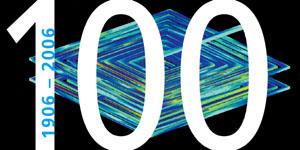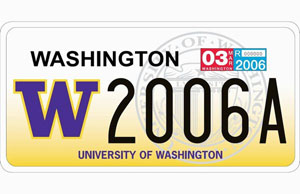« Washington Engineer - May 2006
Engineering alums and friends see new Tacoma Narrows bridge up close

- A tale of two bridges: Tom Draeger, left, 1968 civil engineering alum and president of Bechtel Construction Operations Inc., and Howard Wahl, 1957 civil engineering alum and former leader at Bechtel, pause on the overlook of the old Tacoma Narrows Bridge on the right and its new counterpart going up on the left. Draeger hosted the UW group on the tour.
About 40 alums and friends of UW Engineering gathered last fall to get an up-close look at the largest suspension bridge currently under construction in the world – the new Tacoma Narrows Bridge.
The new span runs parallel and just 60 feet to the south of the old bridge, built in the 1950s to connect Tacoma to Gig Harbor.
Building the new bridge is Tacoma Narrows Constructors, a joint venture of Bechtel Construction Operations Inc. and Kiewit Pacific Corp. The $849 million project involves retrofitting the 1950 bridge in addition to building the new structure.
The new bridge is scheduled to be completed next spring. The retrofit of the old bridge should be done in early 2008.
The outing, co-sponsored by the College of Engineering and the UW Alumni Association, began with a slide show and briefing at the Tacoma Narrows Constructors main office on the site. Tom Draeger, president of Bechtel, told the group that the Tacoma Narrows provides tough conditions for bridge builders.
“The tides are 15 feet, 10 knots a day,” he said. That provided some challenges in positioning and placing the caissons, or foundations upon which the towers sit.
The cassions were built using large barges, upon which the cassions were assembled level-by-level; each new level allowed the cassion to sink further into the water until the “cutting edge” hit bottom. Crews then cut panels out of the caisson “floor,” which allowed them to dredge the riverbed inside the caisson walls, sinking it a further 60 feet into the ground.
During the entire process, the barge had to be held in precise position.
“We used 32 anchors on each one to hold it,” Draeger said. “The anchor chains are the same the Navy uses at Pearl Harbor. Each link weighs 210 pounds.”
Once the caissons were in place, workers built the 510-foot towers from them and began the process of running the cables, which, when done, are 20.5 inches in diameter.
Each visitor left with a small piece of the wire that is bundled to make the cables.
After the presentation, the group donned helmets, reflective vests and protective eye glasses for a hardhat tour that culminated in a walk along the catwalk of the old bridge for a close-up look at the new span that parallels it.
For information on upcoming trips and activities, see the UW Alumni Association Web site.
Electrical Engineering celebrates a century of innovation
• Go to the EE Centennial Web site
When the Department of Electrical Engineering first came into existence at the University of Washington, electricity remained a luxury in many areas of the country.
The year was 1905, and swaths of the United States were still off the grid. It was before the invention of the vacuum cleaner, electric washing machine, refrigerator or long-distance telephone call. Marconi made the first transmission across the Atlantic just four years earlier, and it would be another year before voice and music would be transmitted via radio.
Today, the department does leading work in areas ranging from genome science and nanotechnology to biorobotics and transportation systems.
“It’s come a long way from the original emphasis on electric machines, electrical transmission and communication,” said David Allstot, chair of the department. “Electrical engineering still includes that, but it’s also at the forefront of all the sciences. The field has become highly interdisciplinary.”
Last month, the department celebrated 100 years of growth and transformation with “A Century of Innovators,” a centennial celebration that coincided with the annual Engineering Open House and UW’s Washington Weekend. The event included tours of labs, panel discussions, interaction with past faculty members and opportunities to chat with current faculty and students about their research projects.
The keynote speaker was Bernie Meyerson, chief technology officer for IBM’s Systems and Technology Group, who spoke on new approaches to computing.
New UW specialty license plate available to alums, friends and fans
• Read the news release
• Go to the Campaign UW Web site for details
A team of students at the University of Washington has designed a bold new specialty license plate for Husky fans who want to demonstrate their pride by adorning their ride.
The new plates have added benefit of helping students by helping to fund the university’s General Scholarship Fund. And the donation is tax-deductible.
The newly designed specialty license combines the university’s seal with a purple block-letter W. The design is the result of research involving alumni, athletic fans, students, faculty, staff and parents.
The new plate was unveiled at last year’s Apple Cup, where hundreds of people signed up in advance to be among the first to put the new plates on their vehicles.
The plates cost an additional $40 the year a vehicle owner buys them and an additional $30 per year for as long as they remain on the vehicle. The fees are in addition to all other state and local licensing fees that are due.
Every time a vehicle owner buys or renews UW specialty plates, $28 of the fee paid is transferred to the UW General Scholarship Fund as a tax-deductible contribution.
The plates are available at neighborhood vehicle licensing offices statewide. Vehicle owners don’t have to wait until their current plates expire to purchase the specialty plates.
Mechanical Engineering sets date for centennial celebration
The UW Department of Mechanical Engineering will celebrate its 100th birthday this fall with historical presentations, lab and classroom explorations and a luncheon keynote address by 1946 alum Donald E. Peterson, retired chairman and CEO of Ford Motor Co. The celebration is set for Sept. 15.
Online registration will begin on June 1. See the spring 2006 MEssenger (PDF) for more information.

